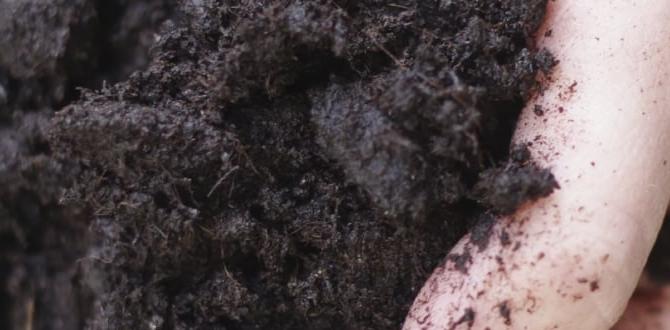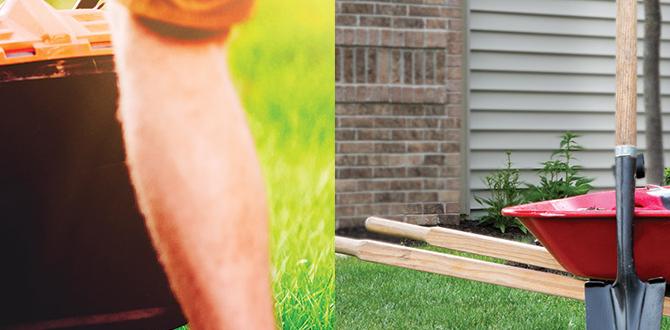Transform your backyard into a thriving garden oasis with these genius tips! This beginner-friendly guide offers simple, actionable advice, creative solutions, and sustainable practices to help you grow your best garden yet, no matter your space or experience level. Get ready to dig in and discover the joy of backyard gardening!
Ever looked out at your backyard and wished it was a lush, green escape bursting with life? You’re not alone! Many of us dream of homegrown veggies, vibrant flowers, or a peaceful corner to relax in. But sometimes, the idea of starting a garden feels overwhelming. Where do you even begin? What if you don’t have a huge yard, or the “greenest” thumb? Don’t worry! This guide is packed with brilliant backyard gardening ideas specifically for beginners. We’ll break down everything you need to know, from choosing the right spot to making the most of your space, ensuring your gardening journey is fun and rewarding. Get ready to discover how simple and enjoyable backyard gardening can be!
Brilliant Backyard Gardening Ideas for Every Beginner
Embarking on your backyard gardening adventure is exciting! Whether you’re dreaming of a salad bowl overflowing with fresh greens, a splash of color with vibrant blooms, or a tranquil spot to unwind, there are countless ways to bring your vision to life. The best part? You don’t need acres of land or a lifetime of experience. Backyard gardening is all about starting smart and enjoying the process. Let’s explore some genius-level ideas that are perfect for beginners, making your garden dreams a reality.
1. Start Small and Simple
The most common mistake beginners make is trying to do too much at once. This can lead to feeling overwhelmed and discouraged. Instead, begin with a small, manageable project. This could be a single raised bed, a few containers on your patio, or a small patch of ground. Focusing on a smaller area allows you to learn the basics of soil preparation, planting, watering, and weeding without getting swamped. As you gain confidence and success, you can gradually expand your garden.
- Choose a Sunny Spot: Most vegetables and flowering plants need at least 6-8 hours of direct sunlight per day. Observe your backyard throughout the day to identify the sunniest locations.
- Good Soil is Key: Healthy plants start with healthy soil. For beginners, using a good quality potting mix for containers or amending existing soil with compost for in-ground beds is a fantastic starting point.
- Easy-to-Grow Plants: Select plants known for their resilience and ease of care. Think lettuce, spinach, radishes, bush beans, zucchini, marigolds, and zinnias. These are forgiving and offer quick rewards.
2. Embrace Raised Beds and Containers
Raised garden beds and containers are lifesavers for beginners. They offer control over soil quality, improve drainage, reduce weed problems, and can make gardening more accessible for those with mobility issues. They also define your garden space beautifully.
- Raised Beds: These can be built from wood, stone, or even repurposed materials. They offer excellent drainage and allow you to create the perfect soil mixture without dealing with compacted or poor native soil. For very simple options, consider fabric raised garden beds.
- Container Gardening: Don’t have a yard? No problem! Pots, grow bags, window boxes, and even repurposed buckets can become thriving mini-gardens. This is perfect for patios, balconies, or even sunny indoor spots. Just ensure your containers have drainage holes!
- Vertical Gardening: Maximize small spaces by growing upwards! Trellises, wall-mounted planters, and tiered shelves are excellent for climbing plants like peas, cucumbers, or vining flowers.
3. Know Your Sunlight and Soil
Understanding your backyard’s microclimates is crucial. Not all areas of your yard receive the same amount of sun:
- Full Sun: 6+ hours of direct sunlight per day. Ideal for most vegetables (tomatoes, peppers, cucumbers, squash) and many flowers.
- Partial Sun/Shade: 3-6 hours of direct sunlight, or dappled light throughout the day. Good for leafy greens (lettuce, spinach, kale), root vegetables (carrots, beets), and shade-tolerant flowers like hostas and impatiens.
- Full Shade: Less than 3 hours of direct sunlight. Best for certain ferns, hostas, and mosses.
Before you plant, assess your soil. Is it hard and compacted? Sandy and drains too quickly? Or is it rich and dark?
For in-ground gardens, improving soil with organic matter like compost is a game-changer. Compost adds nutrients, improves soil structure (helping clay soil drain better and sandy soil retain moisture), and feeds beneficial soil microbes. A soil test from your local cooperative extension can give you specific insights into your soil’s nutrient levels and pH, helping you amend it effectively. You can often find resources for soil testing through your state’s university extension program, like the Purdue Extension – Households, which offers a wealth of gardening information.
4. Choose Wisely: What to Plant?
As a beginner, focus on plants that are known for being easy to grow and relatively problem-free. This sets you up for early success and builds your gardening confidence.
Easy Vegetables for Beginners
- Lettuce and Spinach: Grow quickly, can be harvested multiple times, and tolerate some shade.
- Radishes: Super fast-growing – you can harvest them in as little as 3-4 weeks!
- Bush Beans: Productive and don’t require trellising like pole beans.
- Zucchini and Summer Squash: Famously prolific producers. One or two plants are usually plenty!
- Herbs: Mint (grow in containers to prevent spreading!), basil, parsley, chives.
Easy Flowers for Beginners
- Marigolds: Bright, cheerful, and known to deter some pests.
- Zinnias: Come in a rainbow of colors and attract pollinators.
- Sunflowers: Easy from seed, iconic, and fun to watch grow.
- Nasturtiums: Edible flowers with a peppery taste, and they spill beautifully from containers.
5. Smart Watering Techniques
Watering is essential, but overwatering or underwatering can be detrimental. The best approach is to water deeply and less frequently, rather than shallowly every day. This encourages roots to grow deeper, making plants more resilient.
- Check Soil Moisture: Stick your finger about an inch or two into the soil. If it feels dry, it’s time to water. If it’s still moist, wait.
- Water at the Base: Aim to water the soil directly around the base of the plant, not the leaves. Wet foliage can encourage fungal diseases.
- Morning is Best: Watering in the morning allows plants to absorb moisture before the heat of the day and helps prevent fungal issues by giving leaves time to dry.
- Mulch! Applying a layer of organic mulch (like straw, wood chips, or shredded bark) around your plants helps retain soil moisture, suppress weeds, and regulate soil temperature.
6. Weeding: Your Ongoing Task
Weeds compete with your desired plants for water, nutrients, and sunlight. Regular weeding, especially when plants are small and weeds are young, is crucial.
- Pull Them When They’re Small: It’s much easier to pull tiny weeds than to wrestling with established ones.
- Weed After Rain or Watering: Moist soil makes it easier to pull weeds out by the root.
- Mulch is Your Ally: A good layer of mulch is one of the best defenses against weeds.
7. Companion Planting: A Natural Partnership
Companion planting involves growing certain plants together that benefit each other. This can help deter pests, attract beneficial insects, improve soil health, and even enhance flavor.
- Example: Planting basil near tomatoes is said to deter tomato hornworms and improve tomato flavor. Marigolds planted throughout the garden are believed to deter nematodes and other soil-borne pests. Nasturtiums can act as a “trap crop” for aphids, drawing them away from your more prized plants.
It’s a fascinating area of gardening that can reduce the need for pesticides naturally. Research specific plant pairings to see what might work best in your garden.
8. Creative Garden Layouts
Don’t feel confined to traditional rows. Think about how you can make your backyard garden both functional and aesthetically pleasing.
- Edible Landscaping: Integrate edible plants into your existing ornamental landscape. Blueberry bushes can be beautiful hedges, and kale or Swiss chard can add splashes of color to flower beds.
- Garden “Rooms”: If space allows, create distinct areas for different purposes – a vegetable patch, a herb garden near the kitchen door, a pollinator garden, or a quiet seating area surrounded by sensory plants.
- Pathways: Use mulch, gravel, or stepping stones to create attractive and functional pathways. This not only looks good but also makes it easier to access all parts of your garden without compacting the soil.
9. Gardening Tools for Beginners
You don’t need a shed full of expensive tools to start. A few essential, good-quality items will serve you well.
| Tool | Purpose | Why it’s Essential |
|---|---|---|
| Hand Trowel | Digging small holes, transplanting seedlings, weeding. | Your most used tool for planting and cultivating small areas. |
| Hand Fork/Cultivator | Loosening soil, aerating, weeding. | Great for breaking up compacted soil in small beds or containers. |
| Gloves | Protecting hands from dirt, thorns, and blisters. | Keeps your hands clean and comfortable during gardening tasks. |
| Watering Can or Hose with Sprayer | Watering plants. | Essential for providing life-sustaining water. Ensure gentle watering for seedlings. |
| Pruning Shears (Secateurs) | Cutting small branches, deadheading flowers, harvesting herbs/vegetables. | Clean cuts help plants heal better and promote growth. |
| Shovel/Spade | Digging larger holes, turning soil, moving materials. | Useful for initial bed preparation or larger planting projects. Stainless steel options are durable. |
10. Sustainable Practices for a Greener Garden
Being eco-conscious in your garden is rewarding for both you and the planet. Many beginner-friendly practices are inherently sustainable.
- Composting: Turn your kitchen scraps (vegetable peels, coffee grounds) and yard waste into nutrient-rich compost. This reduces landfill waste and provides free, excellent fertilizer for your garden. Learning to compost is easier than you think! The EPA’s composting guide is a great resource to get started.
- Water Conservation: Use mulch, water deeply, and consider collecting rainwater in barrels.
- Attract Pollinators: Plant a variety of flowers that bloom throughout the season to support bees, butterflies, and other beneficial insects. A healthy pollinator population is vital for many food crops.
- Avoid Harmful Chemicals: Opt for organic fertilizers and pest control methods whenever possible. Many common pests can be managed with simple DIY solutions or gentle, organic products.
11. Garden Design on a Budget
You don’t need to spend a fortune to create a beautiful and productive backyard garden.
- Repurpose Materials: Old tires, wooden pallets, galvanized tubs, and even sturdy cardboard boxes can be transformed into planters or garden beds. Always ensure materials are safe and non-toxic if used for food gardens.
- Start from Seed: Seeds are significantly cheaper than buying established plants. While they require a bit more patience, the savings add up quickly, especially for vegetables.
- Grow from Cuttings: Many plants, like succulents, herbs, and some shrubs, can be easily propagated from cuttings. Ask friends and neighbors for cuttings from their established plants.
- DIY Garden Art: Get creative with painted rocks, repurposed watering cans, or DIY trellises made from branches.
12. Learning from Experience
Gardening is a continuous learning process. Don’t be discouraged by occasional setbacks – they happen to every gardener!
- Keep a Garden Journal: Note down what you planted, when, where, what worked well, and what didn’t. This is invaluable for planning future seasons.
- Observe Your Plants: Regularly check for signs of pests, diseases, or nutrient deficiencies. Early detection makes problems easier to solve.
- Connect with Other Gardeners: Join local gardening groups, online forums, or chat with experienced neighbors. Sharing knowledge and experiences is a fantastic way to learn.
Frequently Asked Questions (FAQs)
How much sunlight does my backyard garden need?
Most vegetables and many flowering plants thrive in full sun, which means at least 6-8 hours of direct sunlight daily. Leafy greens and some root vegetables can tolerate partial sun (3-6 hours). Observe your yard throughout the day to understand which areas get the most sun.
What is the best soil for a beginner’s backyard garden?
For beginners, using a good quality potting mix for containers or amending in-ground beds with compost is highly recommended. Compost improves soil structure, adds nutrients, and helps with moisture retention, creating a healthy foundation for your plants.
What are the easiest plants to grow for a beginner?
Easy-to-grow vegetables include lettuce, spinach, radishes, bush beans, and zucchini. For flowers, consider marigolds, zinnias, and sunflowers. These are generally forgiving and offer quick, rewarding results.
How often should I water my new garden?
Water deeply when the top inch or two of soil feels dry. It’s better to water thoroughly less often than lightly every day. Water at the base of the plants in the morning to prevent disease and encourage deep root growth. Mulching also helps retain soil moisture.
What are some beginner-friendly ways to deal with pests?
Start by regularly inspecting your plants. Many common pests can be removed by hand. Beneficial insects, like ladybugs, can help. Companion planting (e.g., marigolds) can deter pests. For more persistent issues, consider organic pest control sprays made from neem oil or insecticidal soap, which are gentler on the environment.
Do I need a lot of space to start a backyard garden?
No! You can start a garden in surprisingly small spaces. Container gardening on a patio or balcony, vertical gardening using trellises and wall planters, or even a small raised bed can be very productive. The key is to choose plants appropriate for your space and sunlight conditions.
What gardening tools are essential for a beginner?
You’ll need a hand trowel for digging, a hand fork for loosening soil, good gardening gloves, a watering can or hose with a sprayer, and pruning shears for trimming. These basic tools will allow you to perform most common gardening tasks.
Conclusion
Creating a backyard garden is an incredibly rewarding journey, and as you’ve seen, it’s very achievable for beginners. By starting small, choosing the right plants and location, and embracing smart techniques like raised beds, containers, and companion planting, you’re well on your way to a flourishing green space. Remember that patience, observation, and a willingness to learn are your best gardening tools. Don’t be afraid to experiment, celebrate your successes (even the small ones!), and enjoy the process of nurturing life from the soil. Your backyard is a canvas waiting for your green touch, and with these genius tips, you’re ready to paint a beautiful, productive landscape that brings you joy for seasons to come.





